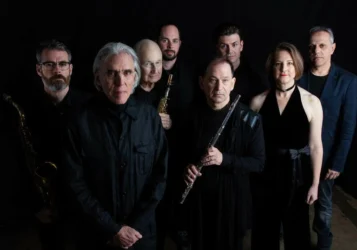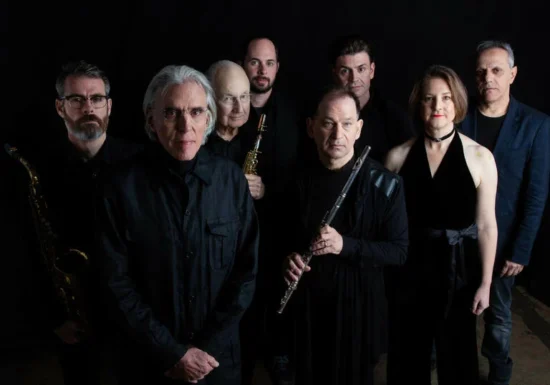 United Kingdom Glass: Philip Glass Ensemble. Barbican Hall, London, 28.9.2024. (MBr)
United Kingdom Glass: Philip Glass Ensemble. Barbican Hall, London, 28.9.2024. (MBr)

Glass: ‘Interlude No.2’ from the CIVIL WarS; ‘The Grid’ from Koyaanisqatsi; ‘Facades’ from Glassworks; ‘Part 8’ from Music in Twelve Parts; ‘Rescue’ from Satyagraha; ‘Funeral’ from Akhnaten; The Photographer, Act III
Anyone familiar with the recording of the Philip Glass Ensemble’s Monterrey concert given in Mexico twenty years ago would have found programmatic similarities at their latest visit to the Barbican. You didn’t need a programme booklet (actually, there wasn’t one) – Glass’s music, despite its looped repetitions, is distinctive enough – to tell you the differences between the two.
The Philip Glass Ensemble was founded in 1968 – by the composer – as a performance outlet for his music, and in that sense almost everything they do (under the music direction of Michael Riesman) is paradigm – although, of course, many others freely interpret Glass’s music however they want. (The complete Piano Etudes are fascinating in this respect.) What differs slightly with the PGE is that they overlay the music with some technology. So, the use of a MIDI keyboard, synthesizers, percussion controllers and computer hardware (and Reisman, of course, took a computer science course at Harvard) gives the music a particular soundworld of its own. This doesn’t change what we know of the music, but it mixes it differently.
The two excerpts from the Glass operas – ‘Rescue’ from Satyagraha and ‘Funeral’ from Akhnaten – really came down to a preference as to how I preferred hearing these pieces played: in their orchestral versions or amplified. Glass orchestrated Satyagraha for strings and woodwind only, although ‘Rescue’ rarely has a discernible darkness to it; rather, it has a fleetness and precision of line to it that I found missing here. ‘Funeral’, on the other hand, never lacked pace or a sufficient percussion line; an underlying brass pulse hovered, but it never felt entirely compelling. Is this version barbaric enough? Well, yes and no; it’s just it has neither the bloodcurdling thrill nor the epic savagery the chorus affords us in the operatic version.
The opening piece, ‘Interlude No.2’ from the CIVIL WarS, comes from Act V of a vast work commissioned by Robert Wilson, of which Philip Glass composed the fifth of six acts written by a sextet of composers. Inspired by the American Civil War, it is Stockhausen in scale (to be performed over a single day, although it never has been) recordings or performances of any sections of it being rare. Glass’s act – the Rome section – is gorgeously written, perhaps partly conscious of the audience it was written for, the 1984 Los Angeles Olympic Movement. Despite the vastness of the subject, the amplification of ‘Interlude No.2’ is enigmatic, even magically done, with hauntingly beautiful woodwind and soft dynamics. Here it was exquisitely played.
‘The Grid’, from Glass’s score for the 1982 Godfrey Reggio film Koyaanisqatsi, has often appeared on PGE programs. A film about the conflict of urban life and the environment, and how the two collide in an apocalyptic way, it would appeal to both Glass and Reisman – although, I think, perceptions of the film and the music work in different ways, even if they are not mutually exclusive, and Koyaanisqatsi can be a provocative film. Glass’s score can in one context be seen as satirical: its hypnotic beauties, its repetitiveness, its tendency to gravitate towards a kind of frenzied madness (which is like a perpetuum mobile in ‘The Grid’) can just wash over you like a wave of sound. But flash back to the film and the austerity of the imagery, the urbanity, and the apocalyptic brutality seem apposite. No matter how fine a performance we get of this piece – and this one was as fine as they get – some of Glass’s film scores are just naked and stripped to the bone without the original concept to apply to them; an exception is perhaps the unusual Dracula (Tod Browning, 1931) which he composed for string quartet. As mercurial as it felt at first, without the compulsive horrors of the imagery to link to the music (even if one tried to recall them) this just felt like an exercise in mechanised music.
‘Facades’, from Glassworks, is I think one of the composer’s most haunting pieces. With a synthesizer doubling for the viola and cello and two soprano saxophones it echoes in its darker tone Akhnaten (which Glass scored for no violins). This was effortlessly played, sensual, and as beautifully toned as I have heard it done.
I have not heard Music in Twelve Parts since 2017 (in this very hall). If the minimalism of this work and its counterpoint can clearly be more of a challenge for audiences this is largely because differentiating the patterns between the parts, and within them, can sometimes be difficult. ‘Part 8’ is no exception to this, and its near 18-minute time span can either be long or short depending on your tenacity or willingness to let yourself become entwined within the labyrinth of sound created. I am not at all sure that ‘Part 8’ is the easiest for audiences. It sometimes seemed one was listening to music in two parallel dimensions – one level fixed, the other in constant flux. The performance was superlative, however – keyboard virtuosity of dizzying agility, peerless breath control on woodwind and an elasticity of tempo that worked in complete harmony with a perfect technique.
The Photographer, Glass’s score for the music/theatre work based on the life of Eadweard Muybridge, was originally written for the Holland Festival in 1982. Act II, which had been on the PGE’s program in Mexico twenty-years ago, can often be a more immersive experience (even though it is slightly shorter) – but with Act III the work has a wider canvas for the players to develop something more expansive. This is almost a transition piece musically – moving away from Einstein on the Beach into the broader sonorities of Akhnaten. Everything about the playing here was nuanced, detailed and taut – allowing the music to move both dynamically (this happens imperceptibly you never really become aware of volume changes) and in tempo over its length. Overlayed vocals were superb.
A misplaced assumption about Philip Glass’s music is that there is an underlying simplicity to it. This is neither true listening to it, and certainly not true playing it. The demands of Glass’s music are implacable on his musicians requiring a technique that is stretched to the limits – and Glass allows minimum room for error here, in music that is both flexible and inflexible, static or latent, dynamic and highly mobile. It is music that is both volatile and unpredictable; stable and unchanging. Such are the challenges of these scores, do they withstand flaws in concerts? If they were any here, they didn’t register. Volume, of course, can be a cover for error but the PGE use sound to overload and engulf the senses and here it was near-ideal. (My watch would tell me that the decibels were too high – though significantly lower than traveling back home on the Northern Line on the London Underground, apparently.) I have certainly experienced more thrilling sound amplification in the Barbican (Stockhausen’s Cosmic Pulses comes to mind) but nothing went to waste here. Keyboard, sax, clarinets, and vocals were all crystal clear and the balance between left and right ideal.
Despite my quibbles over how I prefer to hear some of Glass’s music played (especially from his operas), this was an exquisite evening – and, not surprisingly, a sold-out one at that.
Marc Bridle

I would not say ‘flawless’. I was really looking forward to this concert but for me it was spoilt by being too loud. At times the level was uncomfortable and throughout it meant that the wind instruments did not come across clearly.
By ‘flawless’ I was really referring to the technical quality of the playing, but I suppose if you did find some problems with what you heard then that wouldn’t be the case: concerts are a complete experience, not parts of it.
I agree the Barbican is not an ideal acoustic – and it is probably not built for concerts like this one, as it is not for large scale orchestral works. Volume is an issue, depending on where you are sat, and the outcome is a lack of definition in what you hear. I suspect the balcony (at least nearer the front of it) may have been better, rather than the stalls, for this Glass concert.
There were, however, some things that came across better. In ‘Funeral’, for example, in the orchestral version Glass uses a bass clarinet and second trombone prominently. This can only be replicated on a synth and is not well caught on the PGE’s recordings of this piece; this was the opposite in this concert where it was. On the other hand, ‘The Grid’ felt out of focus to my ears (and, I think for me, uncomfortable) – although this is not music I enjoy in isolation anyway.
In one sense I kept having to remind myself this was early Glass – a slightly tougher, more radical composer than he has become today. He’s no less complex (the Piano Etudes) – just easier to listen to.